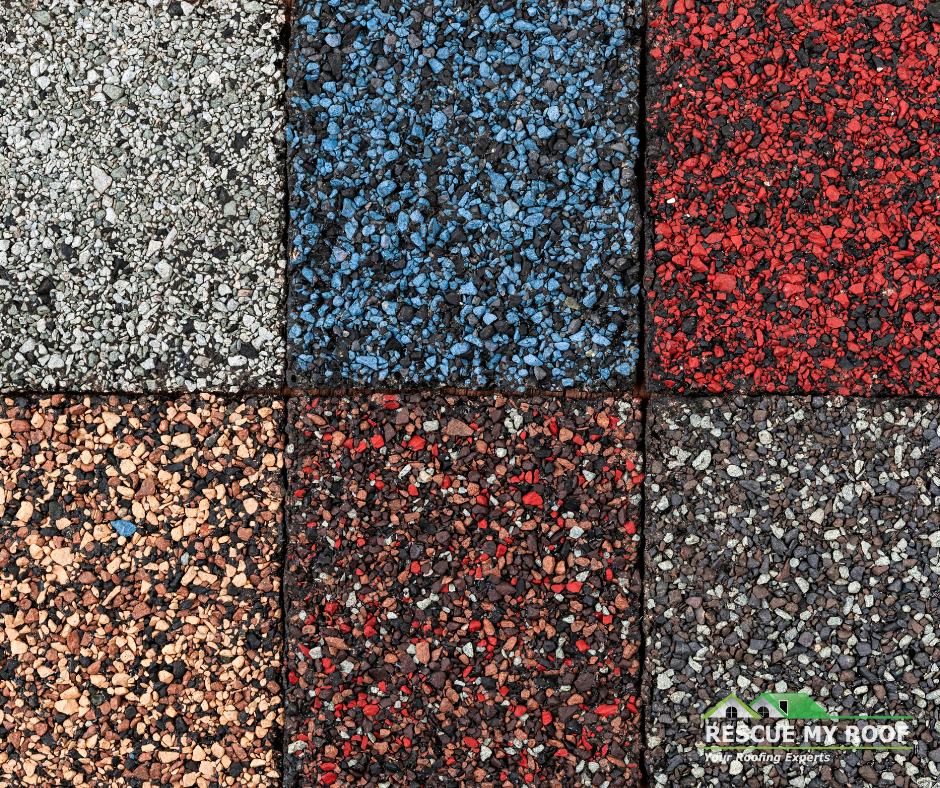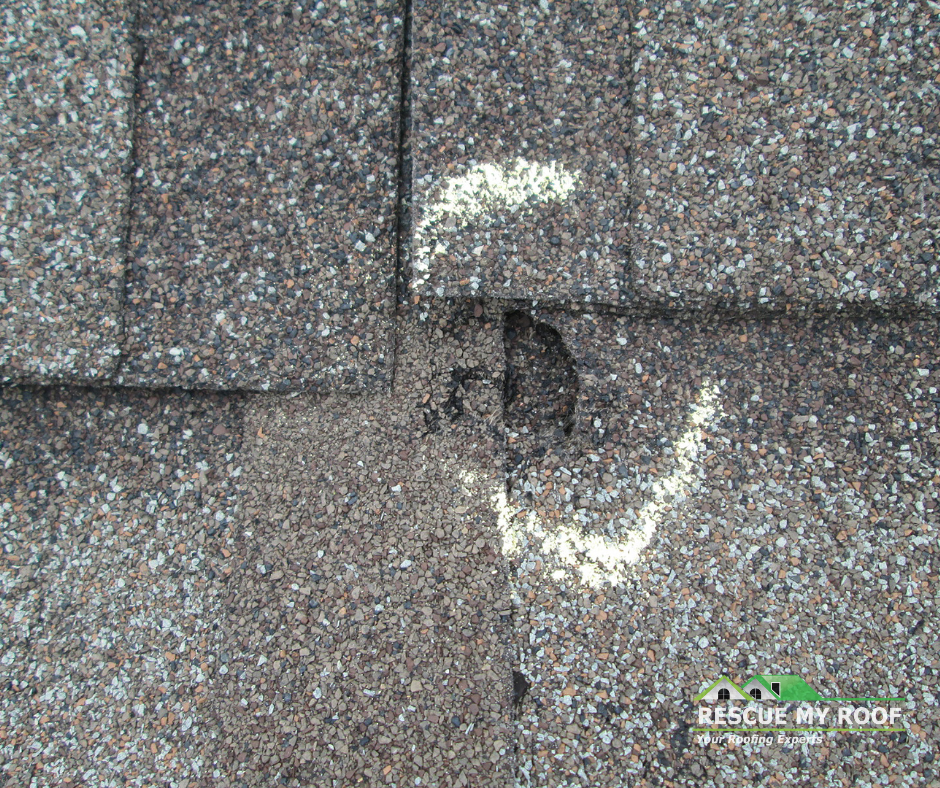6 Asphalt Shingle Granule Loss Causes
Have you noticed bald spots on your roof negatively impacting your home’s curb appeal? Or you’ve spotted a leak and don’t know where it originated.
Facing any home issues can be frustrating – especially when you don’t know why they’re happening or how to solve them.
Rescue My Roof has been working with homeowners for over a decade, helping them tackle roofing issues and keep their homes safe.
One of the biggest hits to your curb appeal – and one of the causes of roof leaks – is granule loss.
We’ll go over what granule loss is, what causes it, and what steps to take when it happens to you. Ultimately, you’ll know how to face granule loss like a pro and keep your roof in top condition for a lifetime.
What Are Shingle Granules?

If you look at any asphalt shingle, you will notice the sand-like texture created by granules on the outer layer of the shingle.
Shingle granules are made of tiny pieces of fiberglass and stone and adhere to your shingle to create a protective layer. Ultimately, granules are your roof’s first line of defense against the elements while adding to the aesthetic appeal of the roof’s design.
A Granules’ Purpose
Beyond adding to your home’s design, here’s how granules protect your roof:
- Protection from UV Rays: The ceramic coating present on most granules is UV-resistant, working like sunscreen on the shingle materials that lay underneath. As a result, they protect your roof from sun exposure.
- Heat Reduction: Granules are reflective (thanks to ceramic coating); they help direct sunlight away from your roof and keep your home cooler on hot days.
- Fire Resistance: Granules are resistant to fire, making it more challenging for exterior fires to penetrate for roof and home.
- Direct Water Flow: Shingles help shed water away from the roof. With the help of granules, water drains off and away from the shingles when water hits the roof.
- Prevents Algae Growth: Algae growth can occur in warm climates, but it attracts and retains moisture on your roof. This can make the shingles vulnerable to rot and additional roof damage. Granules with copper elements can resist algae growth.
- Ease of Installation: Granules make asphalt shingle installation easier as it prevents the shingles from sticking together.
What is Granule Loss?

Granules aren’t forever. Shingles will shed granules over time, but slowly. When your roof’s shingles are constantly exposed to extreme weather or the roof ages, the shingles will deteriorate and lose granules.
However, significant granule loss can lead to unnecessary roof deterioration. Premature granule loss will damage shingles, lead to leaks, and even result in a roof replacement.
A lot of things contribute to granule loss. Even installation will shed some granules. In fact, after heavy rainfall, you may even notice granules in your gutters. You can expect standard wear and tear throughout the shingle’s lifespan.
While minimal granule loss is average, excessive granule loss indicates a more significant issue. Extreme granule loss is preventable, especially when you conduct regular roof maintenance.
6 Common Causes of Asphalt Shingle Granule Loss
Knowing the common causes of granule loss can help you keep your roof’s shingles in great shape and maximize your roof’s lifespan.
Here are the top six common reasons for granule loss:
1. Improper Installation
Not all roofing contractors are made equal. Roofing companies can advantage of homeowners, cutting corners in spending, using lower-quality materials, or not following the shingle manufacturers’ installation instructions.
Failing to meet the installation standards made by the roofing manufacturer is one of the leading causes of granule loss.
If you believe your contractor failed to install your roof correctly, contact other local contractors for a free roof inspection. If there are issues, a trained expert will catch them, and the original company’s workmanship warranty may cover repairs.
2. Foot Traffic
Even if your roof is not a recreational space, it will have foot traffic. During installation or routine maintenance, you or a roofing professional will inevitably walk on your roof.
However, if your roof experiences a lot of foot traffic, it can result in granule loss. To avoid this, minimize walking on the roof.
3. Fallen Debris
When tree limbs, rocks, or debris fall on your roof, it can scrape the shingles and cause granule loss.
Trim large tree branches or shrubs surrounding your home to decrease the risk of rogue plant life causing excessive granule loss.
4. Storm Damage
Heavy rain, snow, ice, heavy winds, and hail storms can lead to damaging your roof. With an asphalt roof, one of the consequences of a severe storm can be severe granule loss.
After a heavy storm, we recommend scheduling a roof inspection with a local roofing professional. Your contractor will assess any damage and recommend repairs.
5. Pressure Washing
Pressure washing asphalt shingle roofs result in granule loss and ensure your home is going to need repairs in the near future.
A pressure washer produces too much force, causing unnecessary damage to the exterior of your home. There are other alternatives to cleaning your roof that will not put it at risk.
6. Old Age
Most Asphalt shingle roofs have a lifespan of 15 to 25 years. After years of exposure to the elements, older roofs will experience more and more loss of granules.
It may be time for a roof replacement if it’s becoming a severe issue. Contact your local roofing contractor for a free estimate.
Replacing Your Roof
Roof replacements can be a costly but necessary venture for homeowners. If you notice extreme granule loss, replacing your roof may be more cost-effective than investing in repairs (that will eventually need to be replaced).
Are you feeling uneasy about diving into the buying process? Read “How Much Does A Roof Replacement Cost” and “Roofing Contractors to Avoid” to learn more.
If you’re ready to start your journey, Rescue My Roof is here to help. Contact us today to get a free estimate.

